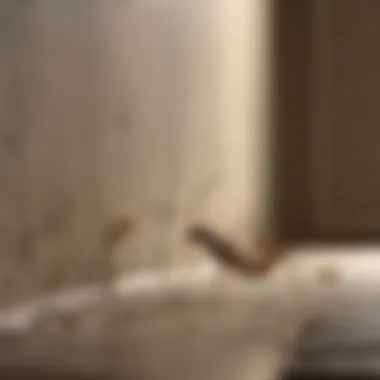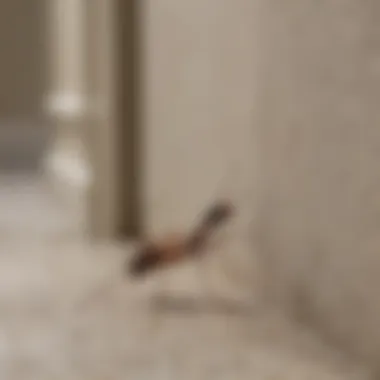Proven Methods to Eliminate Ghost Ants from Your Home Easily and Effectively


Preventive Pest Control Strategies
When it comes to effective pest control, starting with preventive measures is key. To maintain a pest-free environment in your home, several strategies can be implemented. These strategies not only help in eradicating existing pests but also prevent future infestations. Let's delve into some preventive pest control techniques that will aid you in protecting your household from ghost ants and other nuisances.
House Exterior Protection
Protecting the exterior of your house is the first line of defense against pest invasions. Sealing cracks and gaps in walls and foundations is crucial to prevent unwanted entry points for pests. Clearing debris such as leaves, branches, and clutter around the perimeter of your home also discourages pests from lingering near your property. By ensuring that pests have limited access to your house from the outside, you are taking a proactive step in mitigating potential infestations.
Tips for Sealing Cracks
Inspect the exterior of your home regularly to identify any cracks or gaps that pests could use to enter. Utilize caulking or weatherstripping to seal these openings effectively, ensuring a secure barrier against pests.
Clearing Debris
Regularly clean up debris such as fallen leaves, woodpiles, and other organic matter around your property. By keeping your yard clear and tidy, you eliminate potential habitats for pests, reducing the likelihood of an infestation.
Preventing Pests from Entering
Install door sweeps and screens on windows to prevent pests from accessing your home through these entry points. Maintaining a vigilant eye on potential access areas and promptly addressing any vulnerabilities is essential in keeping ghost ants and other pests at bay.
Yard Maintenance
The maintenance of your yard plays a significant role in pest control. By adopting routine yard care practices, you can create an environment that is less attractive to pests. Implementing pest-free methods in your yard maintenance routine will not only enhance the aesthetics of your outdoor space but also contribute to a pest-resistant home.
Essential Yard Care Routines
Regularly mow your lawn, trim bushes, and remove weeds to reduce hiding spots for pests. By keeping your yard well-groomed, you eliminate areas where pests can thrive, thereby lowering the risk of infestations.
Understanding Ghost Ants
Ghost ants are a prevalent issue in many households, known for their small size and pale coloration. Understanding the behavior and habits of ghost ants is crucial in effectively eradicating them from your home. By learning about their physical characteristics and behavioral patterns, you can implement targeted strategies to combat infestations.
Identifying Ghost Ants


Physical Characteristics
One key identifier of ghost ants is their small size and pale color, making them distinct from other ant species. This unique feature allows them to easily blend in with various surfaces, making detection challenging. Despite their tiny appearance, ghost ants are capable of causing significant disruptions in households due to their nesting and foraging behaviors. Understanding these physical traits is essential in devising appropriate eradication methods.
Behavioral Patterns
Ghost ants exhibit intricate behavioral patterns, characterized by their preference for nesting in hidden locations and foraging for sweet and greasy foods. Their elusive nature and tendency to form large colonies can make them formidable opponents in the battle against household pests. By recognizing and analyzing these behavioral patterns, homeowners can devise effective strategies to eliminate ghost ants and prevent future infestations.
Habits of Ghost Ants
Nesting Locations
The nesting locations of ghost ants vary but commonly include areas near moisture sources such as kitchens, bathrooms, and dark crevices. Their preference for damp environments makes these spaces ideal nesting grounds, allowing them to thrive and reproduce rapidly. Identifying and targeting these nesting locations is essential to eradicating ghost ants effectively.
Feeding Preferences
Ghost ants are omnivorous insects with a penchant for sweet and oily substances. Their foraging activities extend to scavenging for crumbs and food residues, posing a hygiene risk in households. By understanding their feeding preferences, homeowners can implement proper food storage practices and reduce the attractiveness of their living environment to ghost ants. Taking proactive measures to address these feeding habits is key to long-term pest control.
Preventive Measures
Preventive measures play a crucial role in eradicating ghost ants from your living space. By proactively addressing potential entry points and minimizing attractants, you can effectively deter these pesky insects. Regular upkeep and implementing simple yet effective strategies can significantly reduce the risk of ghost ant infestations. By focusing on prevention, you not only tackle existing issues but also create a deterrent barrier against future invasions.
Seal Entry Points
Identify and Seal Openings
Identifying and sealing openings in your home is a fundamental step in ghost ant control. By scrutinizing areas where ants can gain access, such as cracks in walls, gaps near windows, and crevices in floors, you can prevent their entry. This method helps in cutting off their pathways, limiting their movement, and ultimately reducing their presence indoors. Although it requires effort and attention to detail, the benefits of sealing openings outweigh the initial work involved.
Use Caulk or Sealant
Utilizing caulk or sealant to close off entry points is an effective approach for ghost ant management. These materials provide a durable barrier that restricts ants from entering your home. Caulk seals gaps and crevices seamlessly, creating a solid defense against infiltrations. While the application process may require precision and patience, the long-term protection offered by caulk or sealant justifies the effort. The advantages of using these products include longevity, weather resistance, and environmentally friendly solutions.
Maintain Cleanliness


Regular Cleaning Practices
Maintaining cleanliness is essential in preventing ghost ant infestations. Regular cleaning practices, such as wiping down surfaces, vacuuming floors, and decluttering living spaces, help eliminate food sources and hiding spots for ants. This proactive approach disrupts ant trails and discourages their presence in your home. Implementing consistent cleaning routines not only deters ghost ants but also promotes a hygienic environment for your household. While it may necessitate dedication and persistence, the benefits of a clean home extend beyond pest control.
Proper Food Storage
Proper food storage is key to deterring ghost ants from infiltrating your kitchen and pantry. Sealing food containers, storing perishables in airtight jars, and promptly cleaning up spills prevent ants from accessing their food supply. By denying them access to nourishment, you disrupt their foraging activities and reduce the attractiveness of your home to these intruders. While organizing and maintaining a food storage system requires discipline, the rewards of a ghost ant-free kitchen make it a worthwhile practice. The advantages of proper food storage include insect prevention, food preservation, and household hygiene.
Natural Remedies
When combatting ghost ant infestations, turning to natural remedies can be a compelling choice. Natural remedies offer a safer, eco-friendly alternative to harsh chemicals, making them desirable for those seeking a greener approach to pest control. In this article, the focus on natural remedies accentuates the importance of sustainability and non-toxic solutions in eradicating ghost ants effectively while minimizing harm to the environment.
Essential Oils
Lavender Oil
In the realm of essential oils, Lavender Oil stands out as a formidable contender in pest control. Its distinct floral aroma not only adds a pleasant scent to surroundings but also acts as a potent repellent against ghost ants. The key characteristic of Lavender Oil lies in its calming fragrance, which simultaneously repels pests and promotes relaxation. Its dual functionality as a natural insect deterrent and relaxation aid makes it a preferred choice for addressing ghost ant issues. However, one should be mindful of the volatile nature of essential oils and their potential to dissipate quickly, necessitating regular reapplication for sustained effectiveness.
Peppermint Oil
Peppermint Oil emerges as another stalwart in combating ghost ants, offering a fresh and minty approach to pest management. Its intense aroma, derived from menthol, creates a hostile environment for ghost ants, deterring them from infesting living spaces. The key characteristic of Peppermint Oil lies in its strong scent profile, which overwhelms ants' olfactory senses, compelling them to seek refuge elsewhere. Its natural composition and efficacy in warding off ghost ants position Peppermint Oil as a valuable asset in the battle against household pests. While its odor is pleasing to humans, it's advisable to use Peppermint Oil judiciously as excessive application may cause overpowering fragrance levels within enclosed spaces.
Vinegar Solution
Turning attention to vinegar solutions unveils a cost-effective and eco-conscious approach to ghost ant eradication. Vinegar, a pantry staple, serves as a potent repellent due to its acetic acid content, which disrupts ants' pheromone trails and deters them from encroaching on living areas. The DIY Repellent Recipe showcases the simplicity of creating a vinegar-based solution by blending distilled white vinegar with water in specific ratios, highlighting the ease of formulation and application. This concoction acts as a formidable barrier against ghost ants, compelling them to retreat to more hospitable environments. However, when utilizing vinegar solutions, it's crucial to maintain a balanced approach to prevent overwhelming odors and potential staining on surfaces. Application Methods play a pivotal role in disseminating vinegar solutions effectively, ensuring thorough coverage of entry points and potential ant pathways to maximize the repellent's efficacy.
Chemical Treatments
Chemical treatments play a pivotal role in combating ghost ant infestations within homes. These treatments are specifically formulated to target and eliminate ghost ants efficiently. The use of chemical treatments offers a quick and effective solution to rid your living space of these bothersome pests. When opting for chemical treatments, it is crucial to consider the safety of individuals and pets in the household. Prioritize products that are in line with safety standards to prevent any harmful effects. Furthermore, chemical treatments should be applied strategically in areas where ghost ants are most active, ensuring maximum effectiveness.
Ant Bait Stations
Ant bait stations are a strategic tool in eradicating ghost ants from your home. Effective baits lure in ghost ants, attracting them to the stations where they consume the poisonous bait. This method proves successful as ghost ants carry the bait back to their colonies, effectively targeting the entire population.


Effective Baits
Effective baits are designed to entice ghost ants while containing ingredients that are lethal to them. The key characteristic of effective baits lies in their attractiveness to ghost ants, ensuring they are drawn to the bait stations. This bait choice is popular due to its ability to eliminate not only the visible ants but also those hidden in nests and colonies. The unique feature of effective baits is their delayed action, allowing time for the bait to be spread within the ant population before taking effect.
Placement Tips
Strategic placement of ant bait stations is crucial for their effectiveness. Placing bait stations near ant trails and entry points increases the likelihood of attracting ghost ants. Ensure that stations are positioned in areas inaccessible to children and pets to prevent accidental ingestion. Regularly monitor and replenish baits to maintain a steady supply for the ants to feed on.
Insecticide Sprays
Insecticide sprays provide a targeted approach to eliminating ghost ants on contact. Targeted application involves directly spraying the ants with the insecticide, rapidly reducing their numbers. These sprays offer a quick solution for immediate ant control, especially in areas of high activity.
Targeted Application
The key characteristic of targeted application is its precision in pinpointing and eliminating ghost ants upon contact. This method is beneficial for swift action against ant sightings, effectively reducing their presence in your living space. The unique feature of targeted application is its direct impact on ghost ants, ensuring rapid results in ant eradication.
Safety Precautions
Prioritizing safety precautions when using insecticide sprays is paramount. Ensure proper ventilation when applying insecticides indoors and wear protective gear to prevent skin exposure. Keep children and pets away from treated areas until the spray has dried completely. Additionally, follow the manufacturer's instructions closely to minimize any risks associated with insecticide exposure.
Professional Extermination
When it comes to dealing with a ghost ant infestation that has surpassed DIY methods, opting for professional extermination is a logical choice. Professional extermination services offer a comprehensive approach to eradicating ghost ants from your home effectively, tackling the issue at its root. With their expertise and specialized equipment, pest control services can identify the extent of the infestation, locate key nest sites, and implement targeted solutions to eliminate the problem.
Utilizing professional extermination services ensures that every aspect of the ghost ant situation is handled with precision and efficiency. Pest control experts have the knowledge to assess the severity of the infestation accurately, allowing them to tailor treatment plans according to the specific requirements of your home. By entrusting the eradication process to professionals, you can rest assured that the ghost ants will be thoroughly dealt with, providing long-term relief from these persistent pests.
Hiring Pest Control Services
Assessment and Inspection
In the realm of ghost ant extermination, the initial assessment and inspection play a pivotal role in devising an effective eradication strategy. Pest control professionals conduct a detailed assessment of your property, identifying key entry points, nest locations, and conducive conditions for ghost ant activity. This thorough inspection serves as the foundation for developing a targeted treatment plan that addresses the unique challenges presented by the infestation.
The assessment phase allows experts to gather essential information about the scope and severity of the ghost ant problem, enabling them to formulate a customized approach to eradication. By pinpointing areas of high activity and vulnerability, pest control technicians can strategize their efforts efficiently, maximizing the impact of the treatment measures. Moreover, the inspection process enables professionals to identify underlying factors contributing to the infestation, allowing them to recommend corrective actions to prevent future recurrence.
Treatment Plans
Crafting tailored treatment plans is a hallmark of professional pest control services when combating ghost ant infestations. These customized strategies are designed to address the specific needs of your home, taking into account factors such as the extent of infestation, structural layout, and environmental considerations. By tailoring the treatment plan to your unique situation, pest control experts can deliver precise and effective solutions that target ghost ants at every stage of their lifecycle.
Treatment plans encompass a range of eradication methods, including the application of targeted baits, barrier treatments, and residual insecticides to eradicate ghost ants comprehensively. Pest control professionals prioritize the use of safe yet potent treatments that effectively eliminate ghost ants while minimizing environmental impact. Additionally, treatment plans may incorporate ongoing monitoring and follow-up visits to ensure the long-term success of the eradication efforts.



